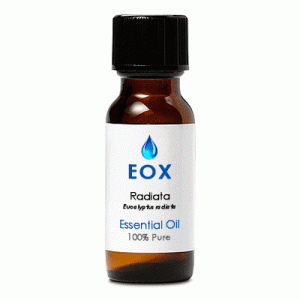|
Characteristics:
A colorless or pale yellow mobile liquid with a fresh camphoraceous, spicy-minty note.
Principal Constituents: These are naturally occuring in the essential oil.
- piperitone (40-50%)
- phellandrene (20-30%)
- camphene
- cymene
- terpinene
- thujene
General Actions:    Open Symbols Key
Open Symbols Key
Analgesic, antineuralgic, antirheumatic, antispasmodic, balsamic,
cicatrizant, decongestive, deodorant, depurative, diuretic, expectorant, febrifuge, hypoglycemic,
parasiticide, prophylactic, rubefacient, stimulant, vermifuge, vulnerary.
Safety:

Non-toxic, non-irritant, non-sensitizing. Eucalyptus radiata oil is used internally in some Asian medicinal practices.
Primary Therapy Agent:
Cuts, sores, ulcers, arthritis, rheumatism, sports injuries, sprains, muscular aches and pains, asthma,
bronchitis, catarrh, coughs, throat and mouth infections, colds, fevers, flu, measles, headaches,
neuralgia.
Secondary Therapy Agent:
Deodorants, disinfectants, mouthwashes, gargles, veterinary practice. Employed for the manufacture of
thymol and menthol (for piperitone).
Important Note: The information on Florapathics.com is
only provided for educational purposes, and further research should be done on each essential oil to be assured
of its proper usage for each individual. Aromatherapy is not meant to be a replacement for care under a qualified
health professional, but should be considered a complimentary modality.
|









